REPRINTED WITH PERMISSION FROM THE CHRISTIAN SCIENCE MONITOR
In Boston, a network of tiny forests collectively provides climate resiliency, spaces to forge connections between neighbors – and food for anyone to come in and pluck.
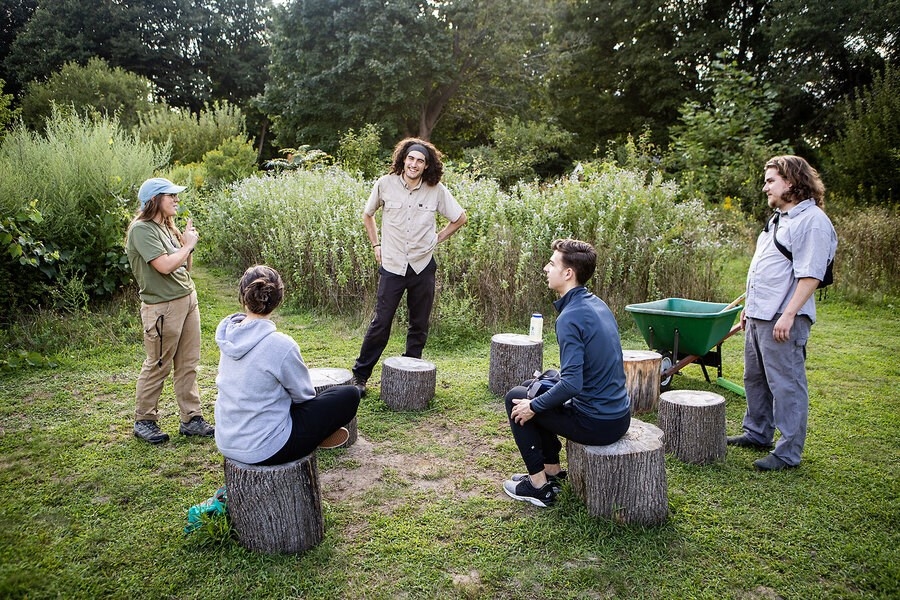 Volunteers listen to maintenance coordinator Emily Carvalho (left) and steward Declan Devine (center) before working in the garden at Boston Nature Center’s food forest. Melanie Stetson Freeman/Staff
Volunteers listen to maintenance coordinator Emily Carvalho (left) and steward Declan Devine (center) before working in the garden at Boston Nature Center’s food forest. Melanie Stetson Freeman/Staff
| BOSTON
Ann Noble has lived in the Boston neighborhood of Dorchester for 11 years. Her third-floor condo lacks the space to garden. And, until recently, she didn’t know any of her neighbors.
Looking for a way to get her hands dirty, she signed up for a Boston Food Forest Coalition (BFFC) cleanup day near her home. She not only found a place to garden, she says, but also met her neighbors for the first time at the Savin Hill Wildlife Garden.
“For me, it’s served two purposes, which is giving back to my community,” says Ms. Noble, “but also meeting some new people who live in my community, who share my values in terms of … having a green footprint.”
Where the Savin Hill food forest stands today used to be an empty lot. The site took five years to build and officially opened to the public in 2022. “The difference is unbelievable,” Ms. Noble says. “You never would have set foot in this property as a person who didn’t want to get mugged … or step on a needle,” she says. Now, it’s full of life, and as it matures, she adds, it will become even more beautiful.
Urban food forests serve a unique role. They aren’t large – the footprint is roughly the size of a housing lot – but they can host over 100 species of plants and trees on an acre. Many BFFC sites have been built in neighborhoods that are lower-income and lack green space. The sites require maintenance – although the goal is for them to become self-sustaining over time. Food forestry differs from community gardening because the space is open for anyone to come in, spend time, harvest, or plant. Most BFFC sites contain plants that produce herbs, berries, fruit, and food for pollinators. In Boston, the network of these tiny forests collectively provides climate resiliency and spaces to forge connections among neighbors.
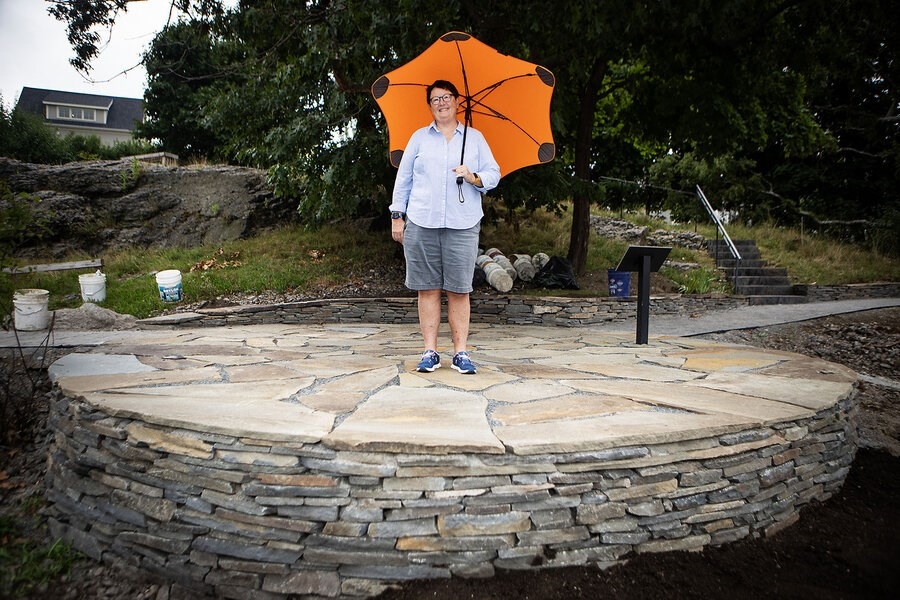 Melanie Stetson Freeman/StaffAnn Noble stands in the Savin Hill Wildlife Garden on a newly constructed patio on a rainy summer day in Boston.
Melanie Stetson Freeman/StaffAnn Noble stands in the Savin Hill Wildlife Garden on a newly constructed patio on a rainy summer day in Boston.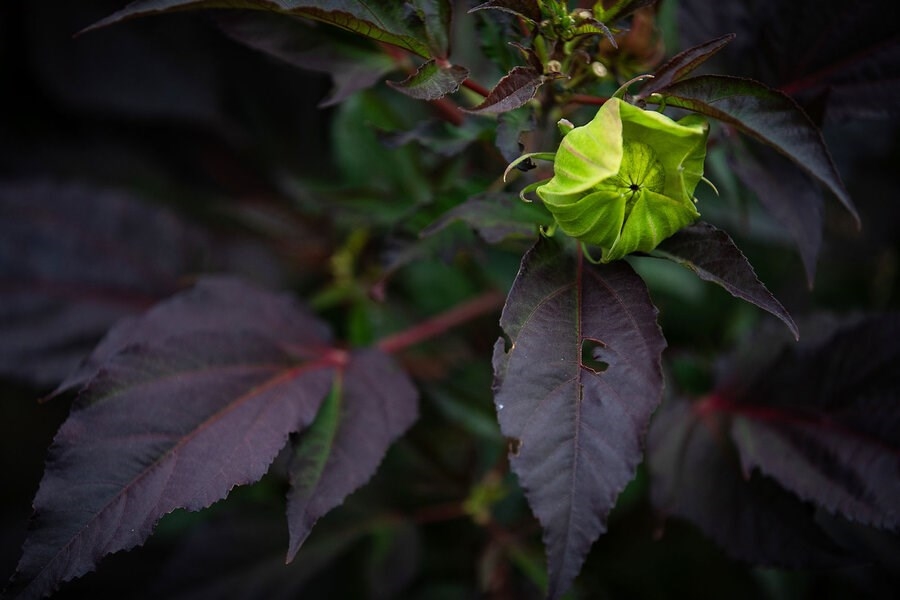 Melanie Stetson Freeman/StaffA bud on a hibiscus plant in the Savin Hill Wildlife Garden.
Melanie Stetson Freeman/StaffA bud on a hibiscus plant in the Savin Hill Wildlife Garden.
“What we plant in our gardens is really a reflection of our family background … and who we are as a people,” says Dr. Cara Rockwell, an assistant professor of environmental studies at Florida International University. She adds that food forestry, or the urban agroforestry system, has been around for a very long time.
BFFC was born out of community organizing. In 2010, a group of neighbors came together to transform its first vacant lot in Jamaica Plain. Today, BFFC has worked with neighborhoods to complete 10 sites, with two more under construction. The organization aims to establish 30 food forests across Boston by 2030. This summer, crops include seaberries, honeyberries, currants, alpine strawberries, and annuals like lettuce, parsley, and collard greens. With high demand from communities for more public green spaces and the City of Boston trying to transform empty lots deemed unsuitable for development, BFFC says it is confident it can reach this goal.
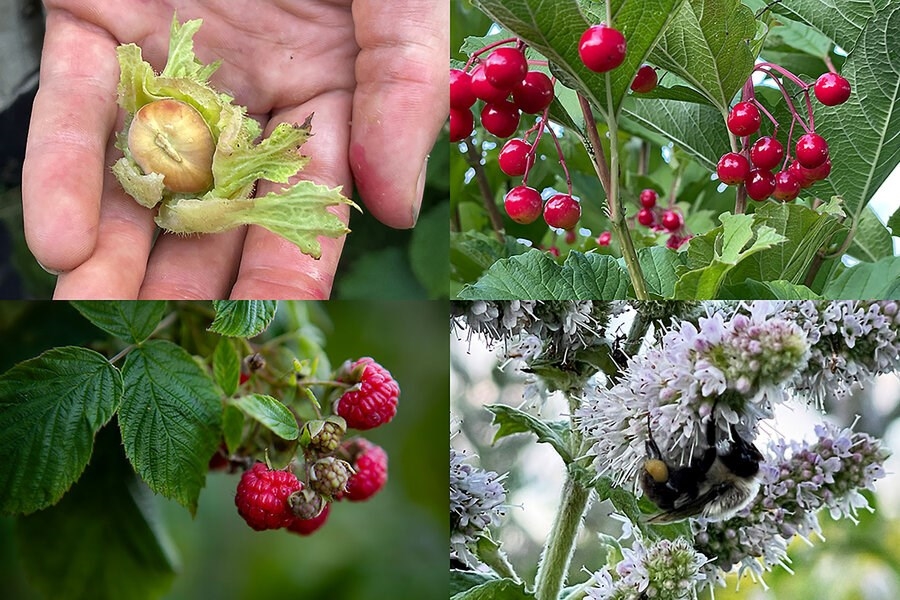 Melanie Stetson Freeman/StaffClockwise from upper left: immature hazelnut, berries on an American cranberry bush, a bee on an apple mint plant, and raspberries at Boston Nature Center’s food forest.
Melanie Stetson Freeman/StaffClockwise from upper left: immature hazelnut, berries on an American cranberry bush, a bee on an apple mint plant, and raspberries at Boston Nature Center’s food forest.
Each site is unique – from neatly pebbled paths to brambles of local wildflowers and shrubs. “I think what makes a food forest is truly the community owning the space and growing and transforming with those spaces,” says Liz Luc Clowes, BFFC’s community engagement and food forest construction director.
The goal for the spaces, she adds, is to support the land’s healing, follow permaculture principles, and be “welcoming and really a third space for people to gather.”
On a July afternoon, Declan Devine weaves through bushes at the Boston Nature Center food forest site, looking for anything edible. He grabs a handful of currants – light pink, tart, and crunchy – and moves on to the black raspberry bush. This urban oasis, with its towering growth designed to mimic forest ecosystems, not only provides shade and relief from the summer heat but also is teeming with life. A few steps down the path, tucked into a small tree, rests a bird’s nest. In the late 1800s, the land was a psychiatric hospital. Eventually, that was torn down and turned into a wildlife sanctuary. About an acre is now home to the Boston Nature Center food forest, established in 2013.
Mr. Devine is a steward for the forest. Here in Mattapan, there are more than 100 species of plants such as bee balm, sweet goldenrod, Siberian peashrub, pear trees, and brightly colored lupines to support pollinators and birds.
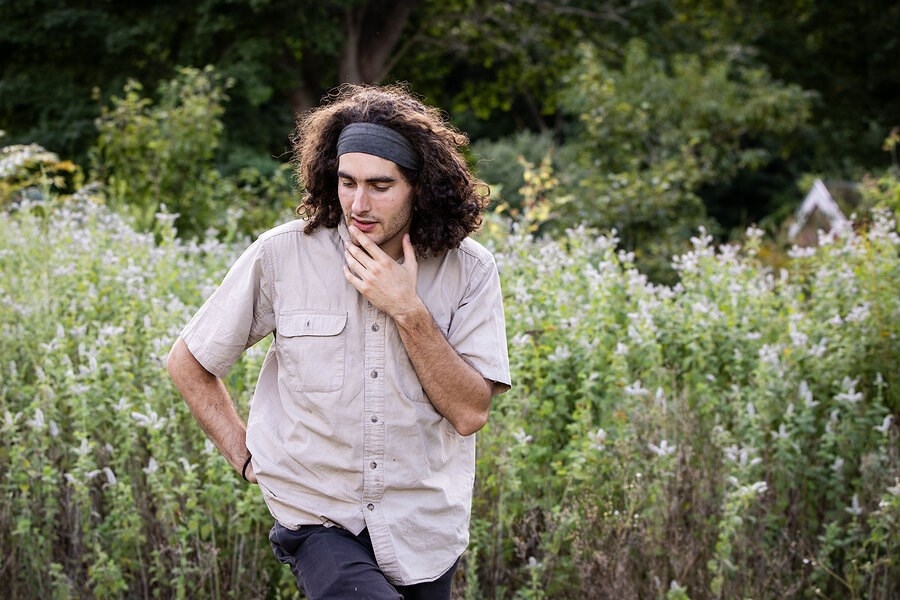 Melanie Stetson Freeman/StaffVolunteer steward Declan Devine listens during a meeting before starting work in the garden at Boston Nature Center’s food forest site in the Mattapan neighborhood.
Melanie Stetson Freeman/StaffVolunteer steward Declan Devine listens during a meeting before starting work in the garden at Boston Nature Center’s food forest site in the Mattapan neighborhood.
“There’s so much life, like blasting out of every square inch of it,” Mr. Devine says.
Climate resilience, trust, and community are core to building a food forest, says Hope Kelley, BFFC's communications manager.
“We say that each project moves at the speed of trust,” Ms. Kelley says. “Building a food forest has to do with planting trees, putting in a landscape, and remediating soil. … But none of that can happen until there’s trust established between BFFC staff and city officials and neighbors who are leading these projects.”
On a recent Wednesday, 15 volunteers, most of whom were new to BFFC volunteer days, got to work removing mugwort, a pesky medicinal and aromatic weed, from around a pear tree. This also helped make room for volunteers to plant native bee balm. Once the weeds were pulled, volunteer stewards used a natural weeding process that would suppress the plant’s return by laying the picked mugwort back down in thick mats and placing big sheets of cardboard on top. The cardboard acts as a new soil layer. It’s called repurposing, and it is how many BFFC sites transform from abandoned plots.
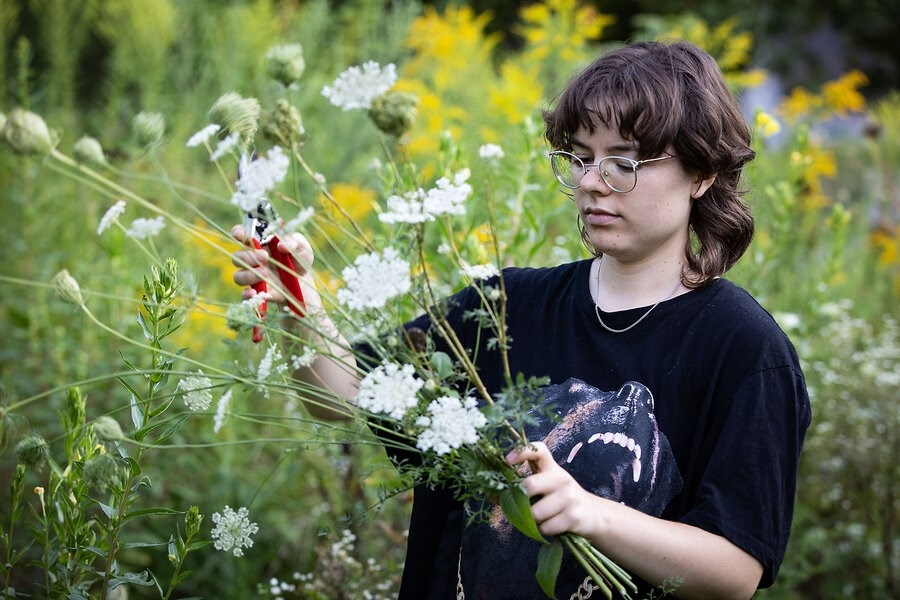 Melanie Stetson Freeman/StaffVolunteer Natali Rabichev picks a bouquet of Queen Anne’s lace at Boston Nature Center’s food forest.
Melanie Stetson Freeman/StaffVolunteer Natali Rabichev picks a bouquet of Queen Anne’s lace at Boston Nature Center’s food forest. Melanie Stetson Freeman/StaffMaintenance coordinator Emily Carvalho brings wood chips to a path being created in the garden at Boston Nature Center’s food forest.
Melanie Stetson Freeman/StaffMaintenance coordinator Emily Carvalho brings wood chips to a path being created in the garden at Boston Nature Center’s food forest.
Ms. Noble, now a steward, has made it a hobby to visit Boston’s various food forests. She explains that she never feels unsafe when she goes to the BFFC sites.
“Our gardens tend to be little gems in a neighborhood and someplace where people can enjoy just going in,” she says. “All the ones I’ve been to have nice little seating areas where you can just sit and rest your feet for 10 minutes. Plus the bigger ecological picture ... we need more green space.”
Page created on 9/2/2024 3:23:13 PM
Last edited 9/2/2024 3:37:25 PM
